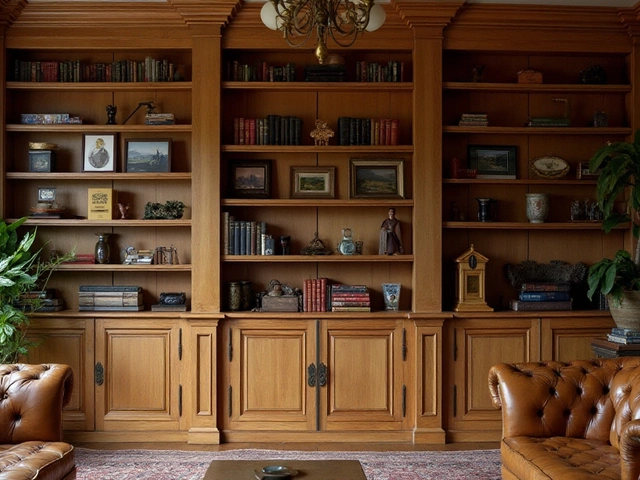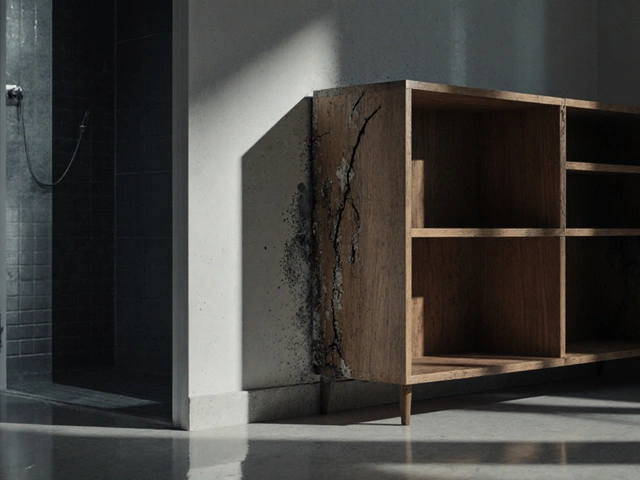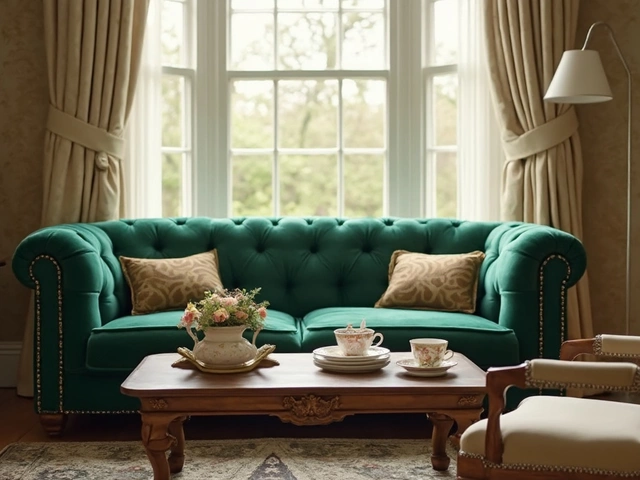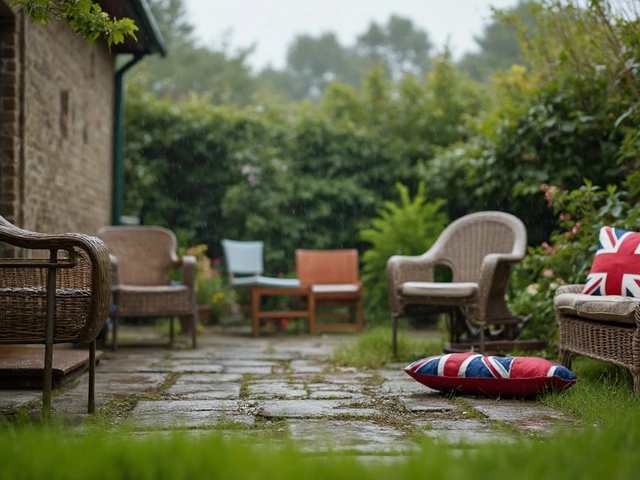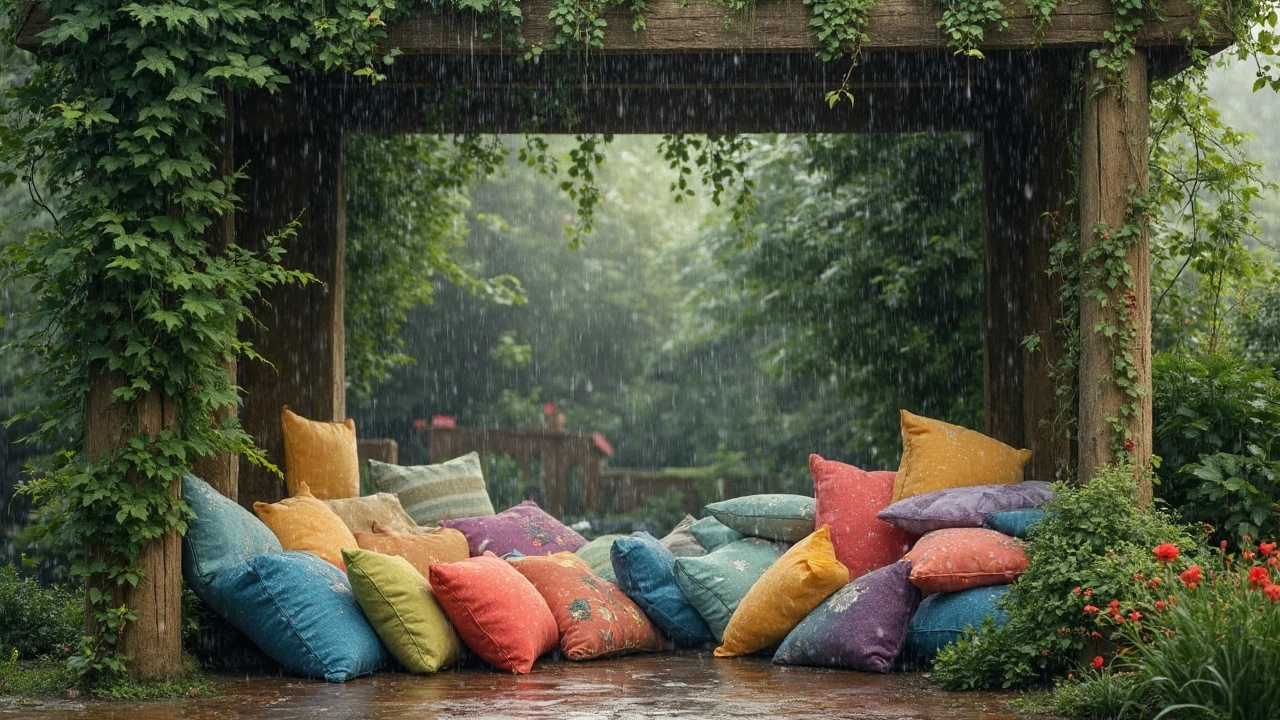 8
Feb,2025
8
Feb,2025
Have you ever watched those clouds roll in and thought, "What's going to happen to my patio cushions?" If you're nodding, you're not alone. Patio cushions add comfort and style to our outdoor spaces, but they aren't a fan of getting soaked. So where do you put them when the skies turn gray?
A quick and easy solution is investing in a waterproof storage bin. These bins are like a safe haven for your cushions, keeping them dry and ready for the next sunny day. If you're caught off guard, you might consider a temporary fix like throwing a tarp or plastic sheet over them until the storm passes. It's not the prettiest solution, but hey, it works in a pinch!
If you're in the mood to get a bit crafty, think about designing a bench with hidden storage or even using your garage space creatively. Not only does this give you a handy spot for your cushions, but it can also add a touch of style to your garden furniture setup.
Want to keep them out rain or shine without much hustle? Consider investing in furniture covers that come with built-in cushion storage. They might be a bit of an upfront cost, but they'll save you a lot of hassle in the long run.
- Why Protecting Patio Cushions is Important
- Quick Fixes for Sudden Showers
- Storage Solutions on a Budget
- Investing in Permanent Storage Options
- Creative DIY Hacks
- Caring for Cushions Post-Rain
Why Protecting Patio Cushions is Important
You've spent time and money picking out the perfect patio cushions to match your outdoor space. But why should they be protected, especially when the weather turns? It's not just about aesthetics or keeping them pretty.
Preventing Damage and Extending Lifespan
Patio cushions take a beating from the elements. When left in the rain, the moisture can lead to mold, mildew, and even rotting. This isn't just about looking bad—it actually breaks down the cushion materials, making them less comfortable and less durable over time. Proper storage keeps them in good shape, so they last for years, saving you money in the long run.
Maintaining Comfort
The inside of a cushion is designed to be comfy and supportive, not soggy and smelly. Rain-soaked cushions can lose their bounce, becoming flat and uncomfortable. By keeping them dry, you ensure they're always ready for a relaxing sit. Trust me, nobody enjoys lounging on a damp cushion!
Avoiding Unwanted Guests
Garden furniture could become a host for bugs and critters if cushions stay out in the rain. Damp cushions are a prime spot for insects to settle in. Protecting them not only maintains them but also keeps your garden area pest-free.
The numbers don't lie—did you know that taking proper care of your patio cushions can extend their life by up to 50%? According to several outdoor furniture manufacturers, proper maintenance is key to longevity.
| Condition | Average Lifespan |
|---|---|
| Unprotected Cushions | 1-2 years |
| Protected Cushions | 3-5 years |
Replacing patio cushions too often is a hit on your wallet. And let's be honest, it's a hassle shopping and matching new ones every season.
Quick Fixes for Sudden Showers
Picture this: you’re relaxing outdoors, enjoying your lovely patio cushions when suddenly, the sky darkens. Don’t stress. There are quick tricks to save those cushions from a drenching.
Let’s start with an oldie but a goodie—tarps. Keeping a tarp handy is an easy way to cover up your cushions fast. Simply spread it over your furniture and tuck in the edges. It requires minimal effort and is super effective for a short-term fix. Plus, tarps are generally cheap, so it won’t break the bank.
Another clever hack is using large trash bags. They might not be glamorous, but they’re perfect when you’re in a pinch. Slide your garden furniture cushions into the bags and seal them tight, putting water worries aside. It’s a bit of a makeshift solution, but reliable when you need to act fast.
Pillows in the Playhouse
If you've got kids or just a small storage shed, use it to your advantage. Toss your cushions in there until the rain passes. It’s better than leaving them out in the pouring rain, right?
Invest in Outdoor Covers
For those who like to be always ready, investing in outdoor furniture covers with a built-in cushion storage section can be a lifesaver. While this isn't exactly a sudden fix, having these covers easily accessible means less panic when the dark clouds roll in. It adds a layer of protection and peace of mind even if you venture out to grab more long-term solutions later.
Don’t let unexpected weather ruin your outdoor vibe. With a bit of quick thinking and these nifty tricks, your cushions will stay dry and cozy, ready to welcome you back outside once the sun decides to show its face again.
Storage Solutions on a Budget
Looking to keep your patio cushions safe without breaking the bank? It's totally doable! Many options can effectively protect your garden furniture cushions from rain, which keeps them lasting longer.
Repurpose What You Have
Start by looking around your house or garage. Got any large plastic storage bins or tubs lying around? These are fantastic for keeping cushions dry. Just make sure they have lids that securely close to keep the rain out.
DIY Cushion Covers
If you're handy with a sewing machine, consider making your own waterproof covers. You can use inexpensive waterproof fabric from a craft store—saving you some cash while keeping your cushions safe and dry.
Get Creative with Pallets
Pallets are not just for shipping! With a little creativity, you can build a simple outdoor storage rack beneath your existing furniture. Pallets can be transformed into a frame that keeps cushions off the ground and covered until the rain ends.
Old Furniture, New Life
Before you toss out that old storage chest, think twice! A quick coat of waterproof paint or liner inside can repurpose it into a great outdoor storage box for your cushions. Functional and budget-friendly!
Garage or Shed Space
If you've got a garage or shed, consider giving a corner of it new life as cushion storage. Add a small shelf or stackable crates, making it hassle-free to grab and store them as needed. These areas are typically dry and ideal for cushion storage.
Some Useful Statistics
| Solution | Average Cost (AUD) | Durability |
|---|---|---|
| Plastic Bins | $10 - $30 | Moderate |
| DIY Covers | $15 - $40 | High |
| Pallet Rack | $0 - $20 | Variable |
As you can see, you don't need to spend a fortune to keep your patio cushions safe from rain. With a bit of creativity and resourcefulness, you can ensure they last season after season.
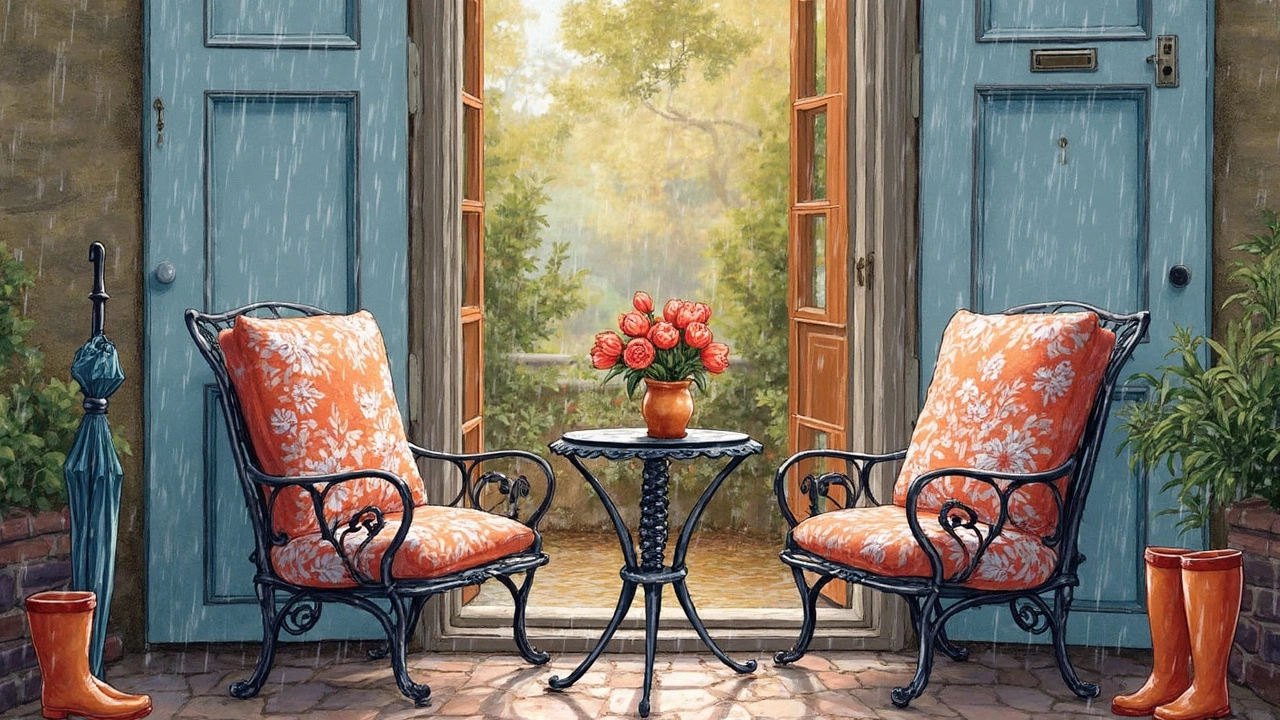
Investing in Permanent Storage Options
Thinking long-term about your outdoor setup? It's a smart move to consider permanent storage solutions for those patio cushions. Not only will they keep your cushions safe and dry, but they'll also save you from the hassle of constantly moving them around.
Deck Boxes: A Practical Choice
Deck boxes are one of the most popular choices for patio cushion storage. They come in various sizes and materials like wood, metal, and plastic. A sturdy deck box can be placed right next to your garden furniture, making it super convenient to stash cushions away when the rain clouds start gathering.
Cabinets and Sheds
If you've got the space, outdoor cabinets or even small sheds can be an excellent solution. They're perfect if you're also looking to store other garden essentials alongside your cushions. Opt for weather-resistant materials that can withstand the elements and keep your cushions in top shape.
| Material | Durability | Cost |
|---|---|---|
| Wood | High | $$$ |
| Metal | Very High | $$$$ |
| Plastic | Moderate | $$ |
As the table above shows, each material has its benefits and drawbacks regarding durability and cost. Your choice will depend on your budget and needs.
Built-in Benches with Storage
If you're planning some landscaping changes, consider adding built-in benches with storage. These are a great way to keep your garden furniture looking sleek while hiding away those cushions. It's a bit of an upfront investment, but the stylish results and practicality are usually worth it.
Ultimately, the best permanent storage option is the one that fits your lifestyle and space. So whether you go for a humble deck box or splurge on a custom-built shed, your cushions will thank you for it!
Creative DIY Hacks
When it comes to storing your patio cushions, a little creativity can go a long way. You don't always need to spend a fortune on ready-made solutions if you're willing to roll up your sleeves and try some DIY magic. Let's explore some quirky yet practical ideas that can keep those cushions from getting soggy.
Recycled Pallet Shed
If you've got some old pallets lying around, why not transform them into a mini storage shed? Pallets are sturdy, and with a bit of effort, you can build a simple enclosure to shield your cushions from rain. All you need are some nails, a hammer, and maybe a splash of paint to make it blend nicely with your garden furniture. Plus, it's a great way to reuse materials that might otherwise go to waste.
Outdoor Cushion Bench
Ever thought about a dual-purpose furniture piece? By adding hinges to a standard outdoor bench, it can open up to store your cushions. This trick doesn't just save space; it also makes sure the cushions are always within reach when you need them. Lined with a plastic sheet inside, it'll keep water out effectively.
Weather-Resistant Fabric Wrap
If you enjoy sewing or a bit of crafting, consider making wraps for your cushions using weather-resistant fabric. By wrapping them tightly, you can leave them outside even during unpredictable weather. These wraps can be tied with strings or Velcro, offering a temporary yet efficient shield from the moisture.
Raised Planter Boxes
This is a neat trick! Build or buy a raised planter box that's large enough to fit your cushions. When rain's on the horizon, simply place them inside and use a waterproof lid or tarp to cover. It serves a dual purpose – your plants get a decorative box, and your garden furniture cushions get a hiding spot.
Table: Cushion Storage Ratings
| Method | Cost | Time to Build | Protection Level |
|---|---|---|---|
| Recycled Pallet Shed | Low | 2-3 days | High |
| Outdoor Cushion Bench | Medium | 1 day | Medium |
| Weather-Resistant Fabric Wrap | Low | A few hours | Medium |
| Raised Planter Boxes | Varies | Depends on design | High |
DIY solutions are a fun and cost-effective way to tackle cushion storage. Not only do they keep your patio cushions dry, but they also add character to your outdoor area. So next time the forecast predicts rain, these hacks have you covered!
Caring for Cushions Post-Rain
So, it rained on your patio cushions. It's not the end of the world, but you'll want to get on it ASAP to keep them fresh and comfy. First off, if your cushions are sopping wet, resist the urge to chuck them in the dryer. Instead, grab a towel and gently press the excess water out of them. Avoid twisting or wringing, as this can warp the cushion.
Drying Out Cushions
Once you've blotted out as much water as possible, elevate the cushions on a rack or some patio chairs to let the air circulate. Placing them in the sun speeds things up, but make sure to flip them occasionally so all sides dry evenly. A breezy day is your best friend here.
Cleaning and Maintenance
If you notice any dirt or stains, mix a bit of mild detergent with warm water and gently scrub the affected areas with a soft brush. Rinse thoroughly to avoid soap residue, which can attract more dirt later. Once they're clean and dry, it's a good idea to apply a fabric protectant spray to fend off future grime and water.
Inspecting for Mildew
Watch out for any musty smells or black spots—these are signs of mildew. If you're dealing with mildew, make a solution of one part white vinegar to four parts water and apply it to the affected area. Let it sit for 15 minutes, then scrub with a brush and rinse well. Sunlight can help kill mold spores, so dry them outside if possible.
From time to time, check your cushions for wear and tear. Seams can weaken after plenty of use, and zipper tracks can get sticky if not cleaned regularly.
Preventative Tips
Consider investing in cushion storage or covers to keep them pristine. Even when the weather forecast predicts clear skies, covering your cushions when not in use can significantly extend their life. Remember, a little bit of care post-rain can keep your outdoor space inviting for those sunny afternoons!
| Maintenance Task | Frequency |
|---|---|
| Blotting Water | After Each Rain |
| Cleaning Stains | As Needed |
| Inspecting for Mildew | Monthly |
